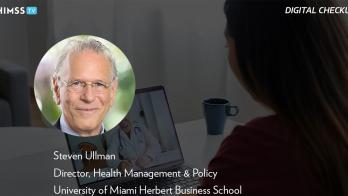
Dr. Denise Gomez, a primary care physician and director of adult medicine at TrueCare
Photo: TrueCare
TrueCare is a community health center in the North San Diego and Riverside Counties area focused on providing quality healthcare to underserved communities.
THE PROBLEM
Because it is a community health center, it provides care to underserved communities, which often have a higher prevalence of uncontrolled hypertension, or high blood pressure. That increases the risk for heart disease and stroke, two of the leading causes of death in the country.
Given that 79% of TrueCare patients are of a racial or ethnic minority and 94% live below the 200% federal poverty line, the provider organization needed to improve hypertension control for patients. It decided to do so via remote patient monitoring technology.
PROPOSAL
"Knowing the value RPM has on improving patient engagement and outcomes, we wanted to find the right RPM technology to help us better manage our growing hypertension patient population," said Dr. Denise Gomez, a primary care physician and director of adult medicine at TrueCare.
The organization went with vendor Rimidi, which combines clinical decision support, remote patient monitoring and patient-reported outcomes in a unified, FHIR-based platform.
"While we tried other RPM technologies before, the tools were difficult to use and we didn’t see the value we needed for our patients," Gomez recalled. "Thus, we were attracted to Rimidi’s platform for three main reasons."
These reasons, she explained, included:
-
The platform enables patients who do not have constant, reliable access to WiFi or smartphones to use the technology. This is because the platform integrates with cellular-enabled blood pressure cuffs, which transmit data from the device directly to the platform for their doctor to be able to see their home blood pressure data, without needing WiFi, smartphones, hubs or apps.
-
The vendor has been doing business for 11 years – more than the five-year minimum TrueCare desired. It has the experience to know what works and what doesn't work.
-
The vendor integrates with TrueCare's Epic OCHIN EHR.
MARKETPLACE
There are many vendors of connected health and remote patient monitoring technology and services on the health IT market today. Healthcare IT News published a special report highlighting many of these vendors with detailed descriptions of their products. Click here to read the special report.
MEETING THE CHALLENGE
When TrueCare first began its current RPM program, it worked directly with the Rimidi team and designed the program workflow within the platform, which included setting customized alert thresholds, automated text messaging in the patient’s preferred language and clinical decision support cards to identify when a patient is consistently not taking their readings.
"To get patients into the RPM program, they had to first be referred by one of our primary care providers," Gomez said. "The qualification was having consistent uncontrolled blood pressure, which was defined by TrueCare as greater than 140/90 mmHg on more than two occasions.
"Once referred, patients then would meet with health coaches who would provide them with instructions on how to use their cellular-enabled blood pressure device, as well as education about their current BP medications, diet and exercise," she continued. "During this meeting, the health coaches would also add the patient to the platform and connect their cellular-enabled device to monitor the patient’s daily readings in near-real time."
Patients then are monitored for readings greater than 140/90. Patients who have met their blood pressure goal are able to return their monitor, and the devices are cycled to newly identified patients who need the care. If the blood pressure goal is not met, the pharmacist or provider is alerted and medications are adjusted.
RESULTS
"We began the program in January 2023 and have continued to ramp up implementation and grow the number of patients each month," Gomez said. "As of April 2023, we have had 70 patients enrolled into the program, with an average of 10 additional patients per month. Impressively, 34 patients have graduated from the program so far, meaning their blood pressure has been controlled.
"Additionally, we see around 30 readings per patient per month on average, meaning we have a high level of compliance among our patients," she added. "Our providers also have been able to reduce medications for patients as a result of their improved hypertension control."
Another interesting note: The program has helped TrueCare identify white coat hypertension in patients, which is when an individual has higher blood pressure readings at the doctor's office than in other settings, such as at home.
ADVICE FOR OTHERS
"It’s important to note that federally qualified health centers and community health centers can’t be reimbursed for RPM," Gomez said. "Therefore, they must rely on grant opportunities and other models of sustainability.
"In our instance, we were able to add Rimidi’s RPM technology with support from a Health Resources and Service Administration hypertension grant," she noted. "While we will continue to look for grant opportunities to expand the program, we also determined in order to sustain the program, we need to add one extra in-person visit for every 13 patients enrolled in Rimidi based on our Preferred Payment System reimbursement amount."
Follow Bill's HIT coverage on LinkedIn: Bill Siwicki
Email him: bsiwicki@himss.org
Healthcare IT News is a HIMSS Media publication.












